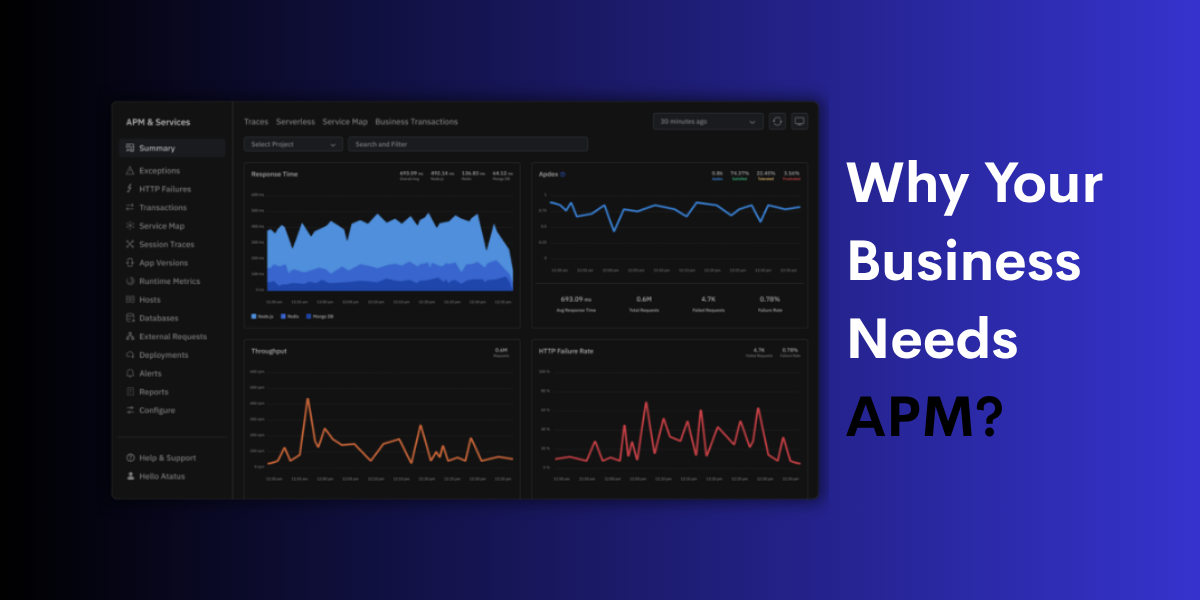Why Your Business Needs APM: 10 Key Benefits You Shouldn’t Ignore
In today’s digital world, how well your applications perform has a big impact on how people see your business, and how well it runs. Whether you are in finance, e-commerce, SaaS, healthcare, or media, your users expect everything to work smoothly, all the time. Even a few seconds of slow performance can lead to lost sales, lower productivity, and unhappy customers.
That’s why Application Performance Monitoring (APM) is so important. APM helps you see how your applications are working from how fast the front end loads, to how the backend processes data, to how your servers and databases are being used. More importantly, it helps your team find and fix problems before they affect your users.
Here are 10 clear reasons why APM is not just nice to have, it’s a must for every modern business.
- Reduced downtime and faster issue resolution
- Improved customer experience
- Increased operational efficiency
- Optimized resource utilization
- Enhanced collaboration between teams
- Improved developer productivity
- Actionable business insights
- Faster time to market
- Revenue protection and growth
- Cost optimization
1. Reduced downtime and faster issue resolution
Unexpected outages and slowdowns can seriously harm your business. Whether it’s a checkout page failing, a login timeout, or an API breaking, these issues don’t just annoy users, they directly lead to lost sales, reduced productivity, and damage to your brand’s reputation.
How APM helps:
Application Performance Monitoring tools work in real-time to track the health of your entire application from frontend load times to backend services and infrastructure. They instantly alert you when something goes wrong, like a sudden spike in errors, a drop in response speed, or a server getting overloaded.
Instead of manually digging through logs or guessing what’s broken, APM gives you detailed traces, error snapshots, and metrics that show exactly where the problem is. This means your DevOps teams or SREs can act fast, fix the root cause, and prevent widespread impact.
Business impact:
- Faster detection: Issues are caught immediately often before users even notice.
- Quicker resolution: Teams spend less time troubleshooting and more time fixing.
- Less downtime: Services stay available and stable.
- Fewer support tickets: Proactive problem-solving reduces user complaints and escalations.
- Stronger trust: When your app is reliable, users are more likely to stick around.
To explore the specific performance issues APM can help you identify and resolve, read our detailed guide, What’s Slowing Down Your App? Common Performance Issues APM Can Solve. It covers real-world bottlenecks, from slow database queries to third-party service delays and how APM tools like Atatus can help uncover and fix them quickly.
2. Improved customer experience
In a world where users expect everything to be fast and seamless, even a one-second delay in loading your app can make customers leave and not come back. Slow load times, broken buttons, and unresponsive features lead to frustration, poor reviews, and lost revenue.
How APM helps:
Application Performance Monitoring gives you a clear view of how users are actually experiencing your application. Using tools like Real User Monitoring (RUM), you can see real-time data on how your app performs across different devices, browsers, internet speeds, and geographic regions. It shows how long pages take to load, where users drop off, and what parts of the app are slow.
APM also includes synthetic monitoring, which lets you simulate user journeys like logging in, searching, or making a payment to catch performance issues before real users ever see them. This proactive approach ensures your app works well for everyone, not just in ideal conditions.
By fixing slow pages, optimizing performance for mobile users, and keeping everything responsive, APM helps you deliver a smooth, enjoyable experience that keeps users engaged.
Business impact:
- Higher user satisfaction: Fast, smooth apps leave a lasting impression.
- Better engagement: Users stay longer and interact more with your app.
- Increased conversions: Faster performance often leads to more sales, sign-ups, or completed actions.
- Stronger loyalty: Happy users are more likely to return and recommend your product.
3. Increased operational efficiency
Without APM, IT and engineering teams often spend hours digging through logs, running scripts, and guessing what went wrong when an issue happens. This slow and reactive process wastes valuable time and often leads to missed SLAs (Service Level Agreements), frustrated teams, and unresolved problems.
How APM helps:
APM tools automatically collect and connect data from across your entire tech stack including frontend performance, backend processing, database calls, and third-party APIs. Instead of piecing things together manually, APM shows you exactly where and why an issue is happening, often in just a few clicks.
You get a complete picture of your application's behaviour, with trace-level visibility that follows a request across services and systems. This lets teams troubleshoot in minutes instead of hours and prevents recurring issues by identifying long-term patterns.
Business impact:
- Faster troubleshooting: No more wasted hours searching for the root cause.
- Fewer disruptions: Issues are handled before they become major problems.
- Efficient teams: Less firefighting means more time for innovation and improvement.
- Reliable SLA compliance: Meet uptime and performance goals more consistently.
4. Optimized resource utilization
Many businesses waste money by adding more servers, CPUs, or memory than necessary just to be safe. While this helps avoid performance issues, it also drives up cloud costs and reduces ROI.
How APM helps:
APM gives you real-time insights into how your applications are using resources. You can track CPU, memory, I/O, and network usage per service, environment, or even individual transaction. This allows you to identify components that are underused (wasting resources) or overloaded (risking failure).
With this level of visibility, you can make smarter decisions about autoscaling, server sizing, and workload distribution ensuring you are not paying for more than you need.
Business impact:
- Lower infrastructure costs: Avoid overspending on unused resources.
- Higher performance efficiency: Ensure critical services get the resources they need.
- Smarter capacity planning: Use historical data to forecast and plan accurately.
- Better cloud ROI: Maximise the value of every dollar spent on infrastructure.
5. Enhanced collaboration between teams
When performance issues arise, developers, operations, QA, and product teams may reach different conclusions about the root cause. Without clear visibility, each team relies on its own data and assumptions, which can slow down the resolution process.
How APM helps:
APM serves as a centralized platform for monitoring application performance. It offers shared dashboards, real-time alerts, distributed traces, and logs that are accessible to all teams developers, DevOps engineers, SREs, QA, and product managers. With everyone working from the same data, teams can efficiently collaborate to identify and resolve performance issues.
Business impact:
- Better teamwork: Everyone is aligned around the same goals and metrics.
- Faster issue resolution: Cross-functional collaboration leads to quicker fixes.
- Stronger DevOps culture: Encourages trust, transparency, and joint problem-solving.
- Improved release quality: Teams work together to test, monitor, and improve performance from the start.
6. Improved developer productivity
Developers often struggle to reproduce performance issues in development or QA environments. What works well in testing might behave very differently in production, where real users, real data, and real traffic patterns come into play. Without visibility into production, fixing performance problems becomes time-consuming and frustrating.
How APM helps:
APM gives developers real-time, code-level visibility into how their applications behave in production. It highlights performance bottlenecks like slow database queries, memory leaks, long-running requests, and more. Instead of sifting through logs or trying to guess what went wrong, developers get clear, actionable insights instantly.
Business impact:
- Faster development cycles: Less time spent debugging means more time building features.
- Fewer performance regressions: Developers catch issues early in the process.
- More confident deployments: Teams can push updates knowing they have full visibility.
- Better software quality: Performance becomes part of the development mindset.
7. Actionable business insights
Performance data isn’t just for engineers, it also holds valuable information for product managers, business analysts, and marketing teams. Understanding how technical performance affects user behaviour can guide smarter business decisions.
How APM helps:
APM tools let you track key user transactions such as logins, signups, purchases, and searches. By correlating these journeys with performance metrics (like load time, error rates, or page responsiveness), non-technical teams can see how system behaviour impacts conversion rates, drop-offs, and customer satisfaction.
This data can inform UX improvements, marketing campaigns, pricing models, and even product roadmap priorities.
Business impact:
- Data-driven decisions: Teams can prioritise features or fixes that improve user experience and revenue.
- Better product planning: Understand which features slow users down and which drive engagement.
- Closer alignment between tech and business: Shared metrics create shared goals.
- Performance becomes a growth driver: It’s not just about uptime it’s about outcomes.
8. Faster time to market
Today’s competitive landscape demands speed. But delivering fast should not come at the cost of reliability. APM helps you move quickly while ensuring your applications stay stable and high-performing.
How APM helps:
Modern APM platforms include deployment tracking, release monitoring, and automated regression detection. This allows teams to monitor the impact of each new release instantly spotting performance changes tied to a specific deployment.
With these feedback loops in place, developers and QA teams can catch performance issues early, fix them faster, and release updates more frequently without introducing instability.
Business impact:
- Faster release cycles: Reduce time from development to production.
- Lower risk in deployments: Spot issues before they reach all users.
- Continuous delivery support: Confidently roll out features in small, safe iterations.
- Stronger competitive edge: Get new capabilities to users faster than your competitors.
9. Revenue protection and growth
Your most important business outcomes whether it's completing a sale, signing up a new user, or generating a report, depend on the smooth functioning of key application paths. If these workflows break or slow down, your revenue is at risk.
How APM helps:
APM keeps a close watch on business-critical transactions like checkout flows, subscription signups, search functionality, and dashboards. It monitors their health in real time, immediately alerting you when performance degrades, errors increase, or third-party services fail.
This allows teams to act before users leave the process, protecting the customer experience and your bottom line.
Business impact:
- Higher conversion rates: Ensure smooth user flows for critical actions.
- Fewer revenue interruptions: Quickly resolve issues that impact income.
- Improved customer lifetime value: Keep users happy and engaged over time.
- Stronger brand trust: Reliable performance builds credibility.
10. Cost optimization
Application and infrastructure inefficiencies come with real costs. Whether it’s idle servers, misconfigured autoscaling, overprovisioned cloud resources, or long debugging sessions, every inefficiency adds up.
How APM helps:
APM tools offer deep visibility into system usage, helping you spot where resources are being underutilized or overworked. You can track performance across environments whether on AWS, GCP, Azure, or hybrid infrastructure and make informed decisions about scaling, provisioning, and optimization.
Business impact:
- Lower infrastructure costs: Identify and remove wasteful spending.
- Efficient use of resources: Right-size instances and services.
- Reduced engineering overhead: Spend less time on performance problems.
- Improved ROI: Maximize what you get from both your infrastructure and your team.
Take control of your performance monitoring with Atatus
Choosing the right APM platform is not just a technical decision, it’s a strategic one. Atatus gives your teams the clarity, speed, and confidence they need to deliver high-performing applications at scale.
With Atatus, you get:
- End-to-End Monitoring across frontend, backend, databases, servers, containers, and APIs, all in a single platform.
- Real-Time Performance Insights that help you detect, diagnose, and resolve issues faster, before users are impacted.
- Seamless Collaboration between developers, DevOps engineers, and SREs through shared dashboards, traces, logs, and alerts.
- Intelligent Alerting and Root Cause Detection to reduce downtime, cut mean time to resolution (MTTR), and improve deployment confidence.
- Scalable Infrastructure Visibility to optimize resource usage and control costs as your systems grow.
Atatus is built for organizations that demand visibility, reliability, and continuous performance improvement. If you are serious about reducing downtime, increasing operational efficiency, and delivering exceptional user experiences, Atatus is the platform built for you.
Learn more about how Atatus APM works in this detailed guide: Atatus APM: Full-Stack Visibility for Modern Engineering Teams 2025
Sign up for a free trial and see how Atatus can improve your application performance before hidden costs start affecting your business.
#1 Solution for Logs, Traces & Metrics
APM
Kubernetes
Logs
Synthetics
RUM
Serverless
Security
More





